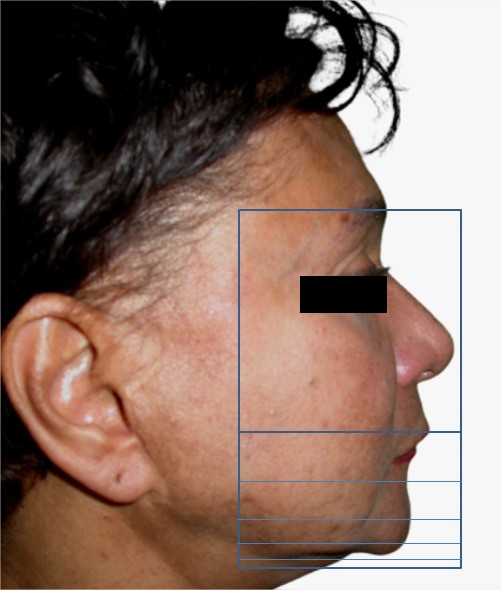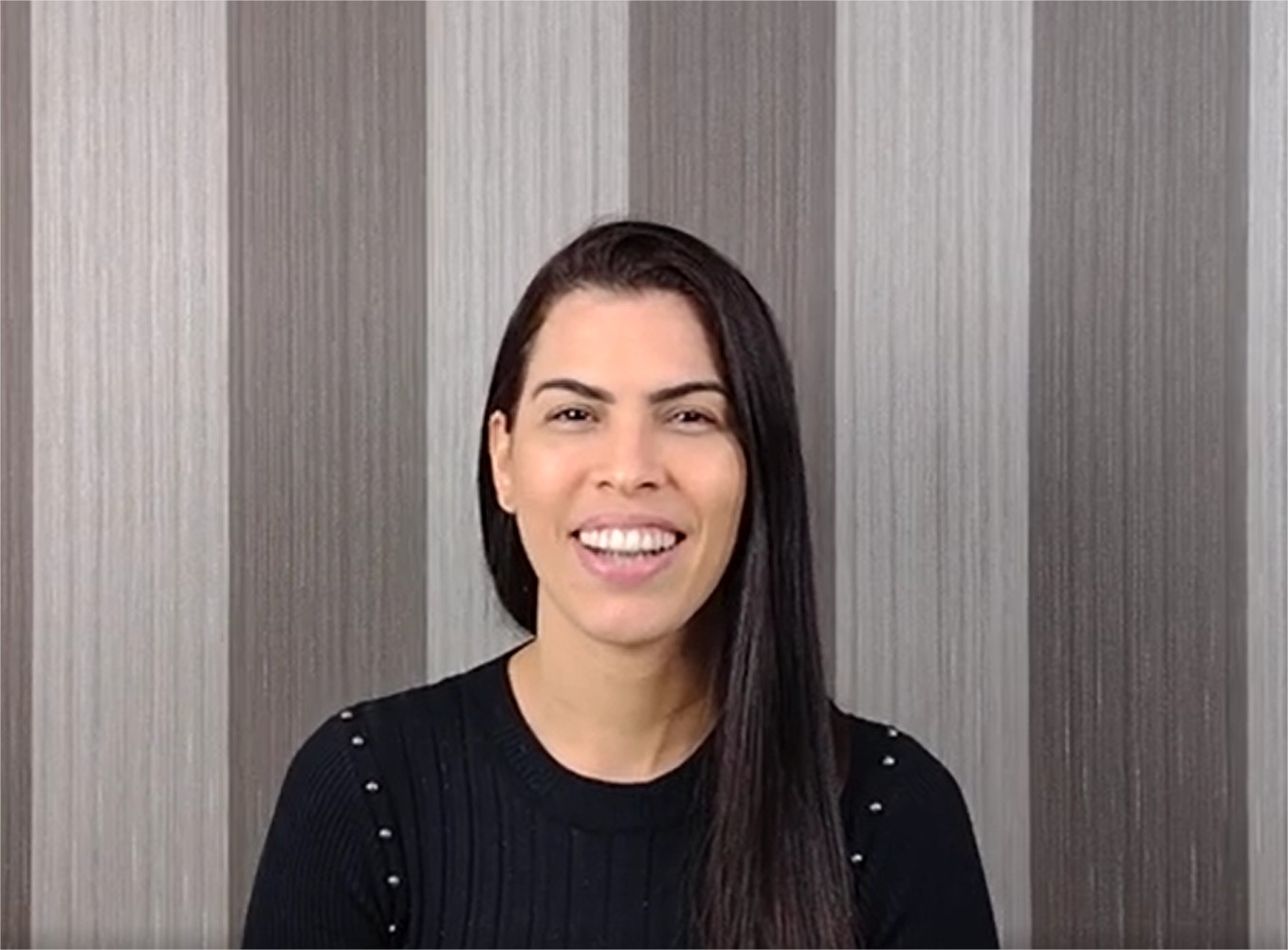Ana Karla possui uma degeneração severa de ambas as ATM que resultaram em dores de cabeça intensas e travamentos da mandíbula.
Ana Karla has severe degeneration of both TMJ that resulted in severe headaches and locking of the mandible.

Mas não é só isso. Uma degeneração da ATM possui sequelas ortopédicas, isto é, altera a relação postural entre a mandíbula (o “maxilar inferior”) e a maxila ( o superior), resultando em uma mudança na mordida (a oclusão dentária), gerando uma MÁ-OCLUSÃO que não pode ou não deve ser corrigida unicamente via ortodontia.
But this is not all. A TMJ degeneration has orthopedic sequelae leading to changes in the postural relationship between the mandible (the “lower jaw”) and the maxilla (the upper jaw). This implies bite problems (dental malocclusion), that should not be corrected solely by orthodontics.
A má-oclusão neste caso é a mordida aberta anterior e o retrognatismo. A mordida aberta anterior ocorre quando os dentes de trás se tocam mas os da frente não e o retrognatismo é o recuo da mandíbula deixando o queixo pequeno. Ambas as coisas ocorrem porque a degeneração da ATM gera uma perda do suporte postural da mandíbula tal e qual uma fundação de um prédio que cede, levando a construção a inclinar-se ou cair.
The malocclusion in this case is the anterior open bite and the retrognathism. The anterior open bite occurs when the back teeth touch but the front teeth do not and the retrognathism is the posterior positioning of the lower jaw, leaving the chin small. Both things occur because the degeneration of the TMJ generates a loss of the postural support of the jaw. This is just like a building foundation failure that causes the building to lean or fall.
Como a torre de Pisa!
Just like the Pisa tower!

A ortodontia utiliza técnicas que visam mover os dentes para uma posição melhor, no entanto, em casos como este, a ortodontia irá corrigir os dentes, mas não o problema ortopédico ( a fundação do prédio ruim), frequentemente resultando em recidivas do problema e permanência das dores e travamentos!
Orthodontics uses techniques that aim to move the teeth to a better position, however, in cases like this, conventional orthodontics will correct the teeth, but not the orthopedic problem (the foundation of the bad building). So the real problem will continue often resulting in malocclusion relapses and permanence of the symptoms, such as the pain and locking jaw of this case!
É por esta razão que é importante uma abordagem que considere a recuperação ortopédica PRIMEIRO, para restabelecimento biomecânico e neurofisiológico da ATM, isto é, que corrija a posição da mandíbula e estabilize a ATM.
So it is important to considers orthopedic recovery FIRST of the TMJ (biomechanically and neurophysiologically). This mean mandible postural corretion and TMJ stabilization.
Após esta primeira etapa, aí sim deverá ocorrer uma segunda fase do tratamento, focada na correção da posição dos dentes com a ortodontia.
After this first stage, there should be a second phase of the treatment focused on the correction of the teeth position. Here is, finally, where orthodontics plays its role.
Conheça um pouco da história de Ana Karla assistindo o depoimento dela:
Know a little more of this case:








Boa Noite! Sofro com dores na buchecha e no maxilar muitos anos, sinto que meus dentes mordem o nervo atrás e me causa muita dor e fico com insônia, sinto arde esse nervo da boca, não sei mas oque fazer. Esssa semana vou fazer a documentação, mas já usei aparelho um tempo as dores aliviaram e quando parei voltou, agora vou colocar novamente, mas queria a cura e não sofrer mais com insônia. Tenho 35 anos e gostariam de uma solução.
Evelice
Pela sua descrição, pode ser que hajam mais de um problema misturado. Para saber se posso lhe ajudar, preciso saber mais sobre seus sintomas. Para isso, você pode acessar o link a seguir e preencher as informações sobre seus sintomas, que a equipe do Instituto da ATM tentará te orientar a respeito de que caminho seguir para buscar uma solução: Instituto da ATM.
Atenciosamente,
Marcelo Matos
Como tratar de uma dormência na pele da minha barriga lado esquerdo. Isto foi depois gue eu tive uma pressão arterial Auta.
Claudimiro, esse blog é sobre disfunção e patologia da articulação temporomandibular, que é a que permite os movimentos da boca, fala e mastigação – um problema odontológico.
Sugiro que procure um médico da dor (algologista) ou neurologista que possa te ajudar com a sua dúvida.
Atenciosamente,
Marcelo Matos
Olá. Diagnosticaram meu filho com retrognatismo. Ele tem 4 anos. Ele ainda baba, é uma criança muito agitada e fica resfriado com frequência, dorme de boca aberta e tem dificuldade de manter a boca fechada. Gostaria de saber com qual idade começaria o tratamento?
Olá Letícia!
A mandíbula pequena é uma das principais condições para o ronco e a apneia infantil (veja essa postagem aqui), que é uma condição que gera muitos problemas na vida da criança por afetar a qualidade do sono e oxigenação.
Veja algumas das várias consequências negativas do ronco infantil:
– Aumento da incidência de infecções respiratórias
– Queda do rendimento escolar
– Problemas de comportamento
– Defasagem no desenvolvimento da coordenação motora
– Baixa estatura
– Crescimento inadequado do rosto e dos maxilares
– Problemas cardiovasculares
Eu particularmente gosto de começar o tratamento de crianças por volta dos 06 anos, mas, em certos casos, é possível iniciar antes.
Acesse o link a seguir e me conte um pouco mais sobre seu filho: conte-me mais sobre os sintomas. O formulário é mais voltado para DTM, mas ainda assim poderei ter uma ideia melhor sobre o caso.
nao entendi se ela fez/tem que fzer cirurgia ou nao!
Todo o tratamento foi sem cirurgia. 😀
Olá, boa tarde! Onde fica seu consultório? O site não está abrindo.
Obrigada
Olá Débora. Você pode ver onde encontrar cada profissional de nossa equipe no link abaixo:
– Clínicas recomendadas para Tratamento da ATM no Brasil e Argentina
Boa noite!
Tenho dor na ATM há sete anos, fo ortográfica tem dez meses e voltei a sentir dor.
Tomografia da ATM normal.
Gilmara, nem sempre normal significa sadio!
Muitas lesões não são vistas na tomografia como, por exemplo, as lesões de disco e ligamentos, que dependem de uma ressonância para serem identificadas.
Outro ponto importante é que a cirurgia ortognática é uma excelente técnica para tratamento das deformidades faciais, mas não é o melhor recurso para tratar os problemas da ATM, pelo contrário, os problemas da ATM podem prejudicar os resultados das ortognáticas.
Eu recebo muitos casos pós-cirúrgicos de ortognática, artroplastia, dentre outras e gosto bastante de ajudar os colegas cirurgiões bucomaxilofaciais a estabilizarem melhor a ATM antes da cirurgia (no preparatório) ou mesmo depois, quando ocorre algum problema. Acesse o link a seguir e me conte um pouco mais sobre seus sintomas para que eu possa verificar em que eu poderia ajudar: Conte-me um pouco mais sobre sua história!
Foi bom pra mim tentar entender um pouco o que acontece comigo, pois meu rosto fica muito inchado na região dos olhos mais agravante do lado direito e queima muito os olhos, não sei explicar direito, só vc sei que queima e da uns choques na testa descendo prós olha e nariz.Preciso muito saber como agir na hora da crise.
Patrícia Severino, piora com o frio?
O que me pode dizer sobre, Fortes dores de cabeça acompanhadas de Caimbras também na cabeça.
Câimbras na cabeça não são sintomas típicos de disfunção da ATM, embora não seja impossível que sinta algo similar a uma câimbra na região da face se os músculos mastigatórios estiverem hipotônicos.
Procure primeiro um “cefaliatra”, um médico especialista em dor de cabeça para descartar outras possibilidades e obter um diagnóstico específico da cefaléia.
Atenciosamente,
Marcelo Matos
Eu estou com esses sintomas…. Estou desesperada o que eu faço?
Carolina, você tem disponibilidade de vir à Salvador? Caso tenha, talvez eu poderei te ajudar.
Atenciosamente,
Marcelo Matos
Boa noite, primeiro muito bom o site! Estou sentindo dor na ATM e indicação de alguns médicos de Cirurguia a um tempo. Estou fazendo exames e ao ler alguns casos aqui no site fiquei muito preocupada. E foi logo hoje que saiu o resultado da minha ressonância. Em resumo deu que tem em ambos os lados: Osteofilo marginal anterior, focos de esclerose no côndilo e na eminência articular e edema na medula óssea do consolo. Sei que eu você não pode me falar muita coisa mas estou realmente preocupada, porque fico com medo de não ser caso cirúrgico. Tenho 29 anos! Esqueci de falar no início
Maria Conceição
O que você descreveu são lesões degenerativas muito comuns em diferentes processos patológicos. Por exemplo, processos autoimunes podem produzir esses danos, assim como certas infecções também. No entanto o tratamento de um e de outro possuem componentes bem diferentes entre si, de modo que primeiro precisa fazer um diagnóstico diferencial. Cuidado com cirurgias em situações onde não há ainda um diagnóstico diferencial e há degeneração das estruturas.
Atenciosamente,
Marcelo Matos